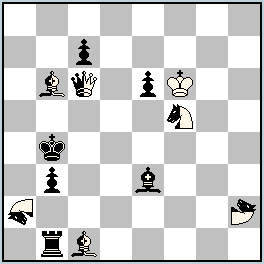|
No.515 Welcome to Michael’s first publication in Original Problems section of JF! |
Original Problems, Julia’s Fairies – 2014 (I): January – April →Previous ; →Next ; →List 2014(I) Please send your original fairy problems to: julia@juliasfairies.com |
No.515 by Franz Pachl & Michael Barth – A difficult h#2 with exotic Take&Make content! (JV)
Definitions:
Take & Make: Having captured, a unit must immediately, as part of its move, play a non-capturing move in imitation of the captured unit from the capture-square. If no such move is available, the capture is illegal. Promotion by capture occurs only when a pawn arrives on the promotion rank as the result of a take&make move. Checks are as in normal chess: after the notional capture of the checked K, the checking unit does not move away from the King’s square.
Giraffe(GI): (1,4) Leaper.
Camelrider: (1,3) Rider. (Moves like a Nightrider but on Camel’s lines only.)
|
No.515 Franz Pachl & Michael Barth
Germany
original – 12.03.2014
 h#2 2 solutions (1+6+6) h#2 2 solutions (1+6+6)Take&Make Giraffe a2 Camelrider h2 Solutions: (click to show/hide)
|



The neutral bishops can move to e3 and they also guard a3/a5. On B1 Black captures one of the neutral bishops, then “makes” to a3/a5 to block the square that the captured nB was guarding. This seems to be a pointless move, but the reason for it becomes clear later.
On W1 the remaining nB captures the bBe3, then switchbacks to restore guard of a3/a5. This results in a check to the bK from the neutral Camelrider h2.
On B2 the nGIa2/nSf5 moves to e3, blocking the check. Then on W2 the nSf5/nGIa2 captures on e3, “making” to the captured pieces original square (a kind of switchback), delivering a double-check mate.
Now we can explain the reason for Black’s first move. In the first solution, if there was a nBc1 then the nSa2 (which is one of the pieces giving double-check) could play 3.nSa2xc1-e3, blocking the check. In the second solution, if there was a nBb6 then the nGIf5 could play 3.nGIf5xb6-e3. The B1 moves are played purely to remove one of these possibilities. Note that 1.nBb2+? won’t work, because it checks the wK, while 1.nBxc7? is impossible, because the nBc7 has no “make”.
The geometry is very nice. The neutral bishops guard e3 and a3/a5. The nGIa2 and nSf5 can move to e3, and (once they move to the other one’s location), the nSa2 checks the bK and can play to c1, while the nGIf5 checks the bK and can move to b6.
A very complex, but very good, problem!
Wonderful complex problem. However, the economy of fairy elements and the economy of the idea always could be questioned.
nQc6 and nCRh2 obviously function as white pieces. Their neutral nature is not needed for the solutions but only for cookstopping. So the fairy-economy is not perfect but compared to the whole content, that perhaps might be neglected.
bRb1 and bPc7 play only in one phase each. This is a minor issue in helpmates, but still, one piece to capture both nBs would be better.
The passive bBe3 is there only to be captured, but since bPe3 would not allow Bishop-like moves to the neutral Bishops in the Make-part, this all looks as quite reasonable and good economy.
But bBe3 leads to the question about the idea. Are the captures in B1 and the switchback-captures in B2 essentially needed? Of course, that is the authors’ idea.
The idea can be to present interesting and complex motivations for the play but also some ornamental effects.
B1 and W1 show T&M effects which Geoff explained as motivated by the beautiful final dual avoidance:
2.nGIe3!(nSe3?)/2.nSe3!(nGIe3?)
Economy of the idea would be to present this idea of dual-avoidance without any superfluous ornamental effects, just as the economy of material would avoid the superfluous pieces. Superfluous ornamental effects might be considered as “Kitsch”. That, of course, crucially depends on personal approach but I think that a concept of “Kitsch” might be needed in chess composition, because of the increasing productivity (it might provoke the authors to search for more depth and subtlety instead of ornaments).
So, let’s compare the original with this example:
W:Kh8; B:Ra6,Kb4,Pb3; Neutral:Qc6,Sf5,Be3,GIa2,CRh2;
H#2; Take&Make; 1.Ra3/1.Ra5 etc.
Dual avoidance is there and the only “ornament” are the trivial selfblocks in B1. Two nBs are not economical for this and the same selfblocks in the original would be as much trivial despite the ornamental T&M captures, but…
As it was explained, the motivation is not to block the flights (they’re already guarded by nBs), but to annihilate a proper nB which would cause a dual in B2.
Selfblocks are only a compensation for the lost flightguard.
This significantly increases the thematic complexity and depth of the idea, there’s certainly no “Kitsch” in that.
For achieving this, bBe3 seems inevitable, as well as the switchback-captures in W1. I don’t consider such captures of completely passive officers as thematic or nice but here it’s quite acceptable as an effective constructional tool. Therefore the switchbacks are not kitschy although as an esthetic effect they are ornamental.
After all this, a remarkable composition.